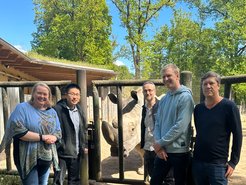Why psychiatrists are trying to save the last northern white rhinos
An international team of scientists from the MPIMG, University Medical Center Schleswig-Holstein (UKSH) and the San Diego Zoo Wildlife Alliance (SDWA) have decoded the nearly complete genome of the northern white rhinoceros.

The study, which has now been published in the prestigious journal PNAS, could help save this nearly extinct rhino species. Only two female animals remain, and they are no longer able to reproduce. Rescue is only possible with the help of modern biotechnology.
The comprehensive investigations are comparable to projects aimed at decoding the human genome, such as the well-known Human Genome Project, in which the MPIMG was also involved.
The researchers are part of a global effort to develop new methods to save endangered animals using stem cell technology. The idea is to bring back animals like the northern white rhinoceros using cells that have been preserved in freezers for years. However, these frozen cells first need to be transformed into a special kind of stem cell called “induced pluripotent stem cells” (iPSCs). These stem cells are important because they have the potential to develop into egg or sperm cells in the lab, which could one day make the birth of new northern white rhino calves possible.
A major hurdle in this process is that the genetic information in these cells often gets damaged while turning them into iPSCs. The new study published in PNAS describes a way to check the quality of these stem cells and select only those with intact genetic information. This step is critical to make sure the resulting cells are healthy enough to be used for reproduction.
Importantly, the methods developed in this study are not only useful for saving animals. The same genetic techniques will also be applied to human medicine, for example, to personalize treatments for mental health conditions like depression based on a person’s unique genetic makeup.












